Naxos
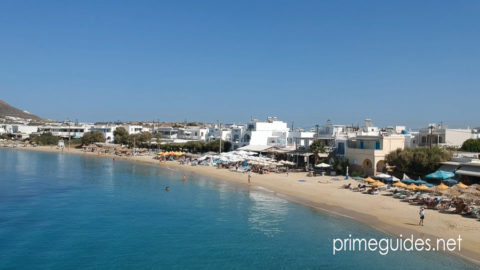
Naxos town & the some of the best beaches & sites of Naxos
Sitting in the Cyclades chain of Islands, Naxos sits with easy reach of both Myconos and Santorini. Although it has its own small airstrip, most visitors will access the island by sea. Popular with the Greek traveller the island can also be accessed via Pireus via regular ferry such as the Blue Star line, or by the faster Seajet service which departs from Pireus, Rafina or Crete.
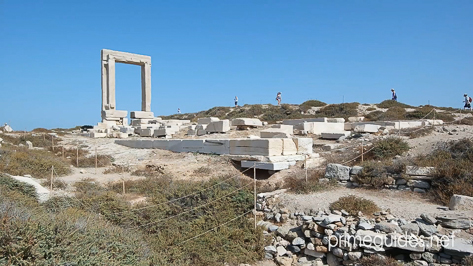
On arrival in Naxos, the visitor will be greeted by one of the islands most famous sites. ‘The Portara’ sits on the tiny islet of Palatia (assessable via a causeway) directly next to the harbor. The structure is actually the doorway to the temple of Apollo which no longer stands but who’s ruins can still be seen. The entrance to the harbor gives access to the town and here you will be able to hail a taxi or directly opposite, the bus station will be able to sell you a ticket for the excellent bus service. If you have arranged a pick up from one of the hotels, here is where you will be met.
Naxos town (or Chora, to give it its correct name) sits on the western side of the island close to the islands Airport. Head for the Old part of town which is accessible from the harbour road. Here you will find a maze of alleyways and streets leading up the hill to the old castle. Hidden amongst the labyrinth, souvenir shops compete with more up market art dealers and coffee shops (the 520 has good views and excellent coffee) with views over the harbor and the neighboring island of Paxos to the West. For a more intense shopping experience, find the little square, set off the harbor road (opposite the little church on the island in the harbor). At the far left hand corner and almost hidden from view is an entrance to the little ‘Agora’ featuring an interesting array of tourist shops and market stalls selling local produce together with a good selection of street tavernas for that authentic holiday experience. Well worth a visit in the evening, particularly with the efficient bus service.
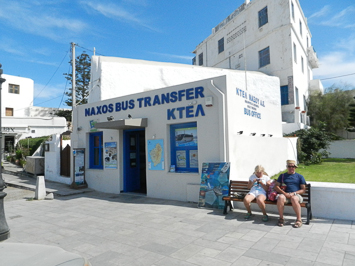
In fact it would be possible for the traveller to disembark from the ferry and just hop on one of the coastal busses heading south as they have regular stops all the way down the west coast giving access to most of the popular tourist areas. This is a regular and efficient service so if you traveling light, it may save you the taxi fare.
The West side
Traveling South from Naxos town, you will pass in between the bay of Ag Georgios. Located on the edge of town, it features a selection of small hotels (and a sizable supermarket) Set on the landward side of the road, backpackers are catered for with the Naxos Camping site which comes complete with its own pool and views of the islands airport which is located next door. Continue past the hotel Golden Sun and the up market Kouros Art hotel and you will come across probably the most developed village on the west side
Agios Prokopios
Located just 5.5 Km from the main town, Agios Prokopios offers organized bathing along a pleasant crescent of fine sand backed by the village. The greatest concentration of sun loungers is located in front of the village so for a bit of peace & quiet, head for the northern end of the beach. The village features a seafront road lined with Tavernas and bars which backs onto the main road which runs through the village with more fast food options, supermarkets and car/bike agencies. Divers are catered for with dive schools at the south end of the beach, where the sand eventually runs out. A short stroll around the headland will bring you to Agia Anna.

The crescent beach in Agios Prokopios is considered to be one of the best in Greece.
In summer, parking can be at a premium so it may be best to consider using one of the islands busses, which stop in the village.
Agia Anna
Although tourism is well established in Agia Anna, visitors with find it much more relaxed than its busier neighbour. The fine golden sand continues right the way to the harbour and beyond, but the beach tends to be much narrower here. There’s no actual coat road here which is part of Agia Annas charm with tavernas fronting right onto the beach with many of the tables being laid out on the sand for that unique beach dining experience.
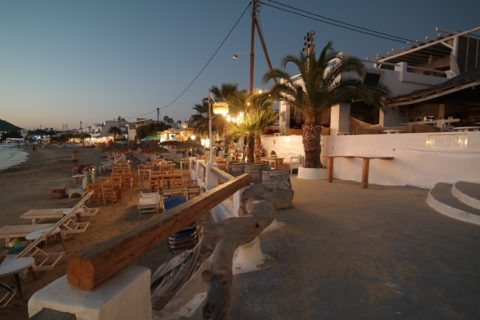
The main road continues around the back of the village and continues along the coast from the harbour jetty where the main bus stop is located. Agia Anna caters for most tastes in evening dining, from relatively fast food through to the full Greek Taverna experience. The tiny church of Ag Nikolios is well worth a look. Located at the end of the beach and on the headland, it offers great views of the rock formations below and the sunset over Paros.
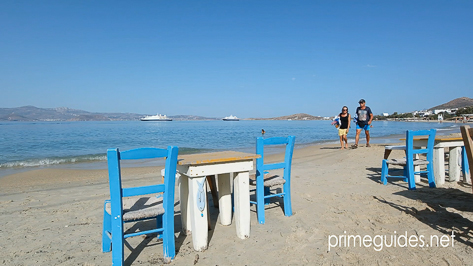
Margaras
Beyond the Church, a board walk continues past the nudist beach and onto the village of Magaras. There’s no village as such on the coast road, just a collection of tavernas supermarkets which back onto the vast expanse of sand which runs all the way down to the village of Plaka.
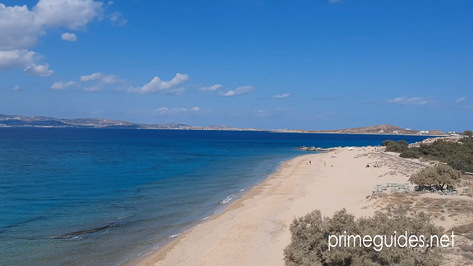
For those wanting a more organized destination, this is the last village before the tavernas start to thin out and the space between the hotels increases.
Plaka
For a more secluded experience, Plaka probably ticks all the boxes. Beach life is still organized, with sun-loungers and plenty of shade to rent but the sand dunes are bigger here and the road unmade. The service bus still runs here though so it’s by no means difficult to access.

Plaka beach, showing Magaras in the distance, with Ahia Anna and Agios Prokopios in the distance.
The South
Beyond Plaka, the coastal villages are more spread out. Mikri Viglas features a good beach (and a very pleasant bakery) and caters for the sail board set. Its split into two bays, the north being quite windy so bear this in mind when booking you’re accom. The south bay, however is more sheltered and provides a more relaxed beach experience.
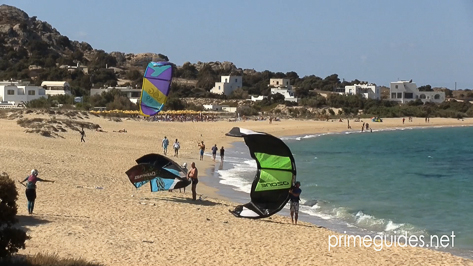
Other beaches worth visiting in the south west are Kastraki, Glyfada and Pirgaki.

Glyfada is another beach destination worth considering with a near deserted stretch of sand when we visited late in the season. A few accommodation blocks (such as the Glyfada Beach Studios) sit just about on the beach so if you want a laid back beach side location, this should feature on your short list.
Naxos’s fine sand continues to feature in its coves and bays, all the way down to the southern tip of the island where the tarmac road finally peters out. One location you may want to visit is the un-finished hotel at Alyko. Set on the headland, this would have been an impressive location if the money hadn’t run out! Artists have painted murals on the walls and it’s certainly makes for an interesting visit. Tread with caution though; there are holes in the concrete floor so a visit after dark is certainly not recommended.
The Centre and the East coast
Heading inland from the West coast, history buffs may want to head for the village of Sangri and the nearby Temple of Dimitra. As you head through the village from the north side, ignore the fist left hand turn opposite the café and the windmill (it’s very bumpy and narrow) but carry on through the village and down the hill, where you will see the temple.
Restored to its current state in the mid 90’s by German archeologists, the Temple dates back to the 6th century BC. Demetra, being the goddess of grain would have approved of its location on the fertile plains below Sangri, There was no charge for entry when we visited and the site is well worth scheduling into a tour of the island.
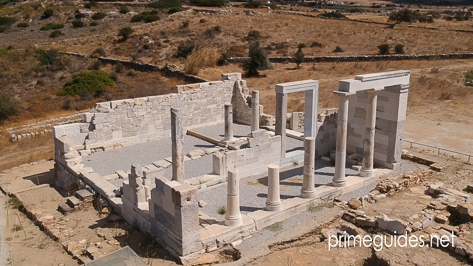
Access to the east side means travelling over the mountain via the village of Apiranthos. The journey provides some great views over the island as the road winds its way past the villages of Chalkio, famous for its distillery which makes Citron, the local drink of Naxos and Filoti (the islands largest village) both worth stopping off for a look at.
You'll also be able to see some of Naxos's impressive blue domes churches, iconic symbols of the Cycladic islands.
Moutsouna
The former mining town of Moutsouna sits on the Eastern side of the island. You will find the turning off the main road at Apiranthos. The road winds down to the coast and this will take you around 20 minutes each way. As you decent, you will see evidence of the quarrying of Emery, which was once a major export for the island. The conveyor buckets still hang on the cables, looking ready for work and these continue all the way to the village, stopping just short the of the jetty. In fact the ruins of the base station are still visible, together with the rail lines which continue onto the quay side and finishes beside the enormous crane gantry which still stands today. Beside the quayside, a small but pleasant beach is backed by a couple of tavernas which makes it an ideal place to visit if you want to sample to local catch. There’s also a bar selling drinks should you want to just take in the views.
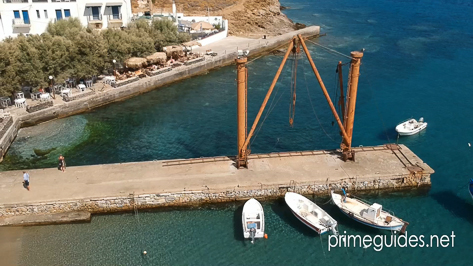
South of Moutsouna the road follows the coast down to Psilli Ammos beach and eventually Panormos. Both pleasant beaches but you have to drive all the way back up to Moutsouna to get back on the main road at Apiranthos. Its worth taking a walk around Apiranthos which is thought to date back to the 17th century. The village is built around two towers and offers plenty of leafy shade whilst you decide on your next destination.
If you wish to proceed north, head for Apollonas which consists of several cafes and tavernas fronting onto the small town beach. Popular with Greek visitors, the main interest in Apolonnas is the Kouros statue, located close to the village. It can be found on the road above the village. In fact, you will see a sign for what looks like a village, and which must account for one of the shortest in Greece, as the sign coming the other way is around 10 meters away, giving room only for the flight of stone stairs which take you upto the statue. Originally thought to be Apollo, the statue, weighing in at around 80 tonnes still lays where it was carved.
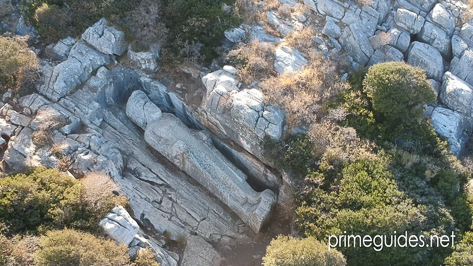
Cut free on three sides, the statue was never finished and no means to transport it from its present home are detectable. Many theory’s exist about why this is the case but none were ever proven. The features are quite distinguishable although the statue id better viewed from a drone (as in the accompanying video)
Although a visit to Kouros is well worth it, you should take into consideration the drive back to town along the north coast. Although some of the villages are pleasant, the drive is long and I wouldn’t advise doing at the end of a full island tour.
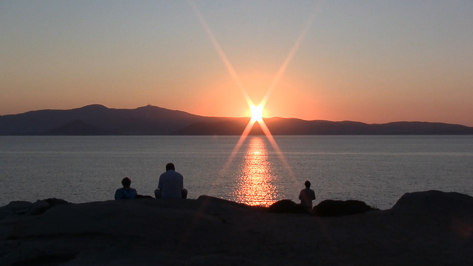
Take a couple of days at least to see the sights of the Island, maybe the west side one days and the East/north the next. The beaches of Naxos are varied, from the long and organized to the small and deserted so once you’ve taken the tour, return to you’re favorite beach and relax!
We stayed at the Kalia Studios in Agia Anna and arrived from the UK via an overnight stay in Santorini. Flights were booked via EasyJet and accommodation booked through booking.com
![]()
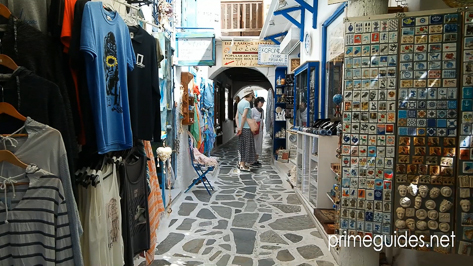
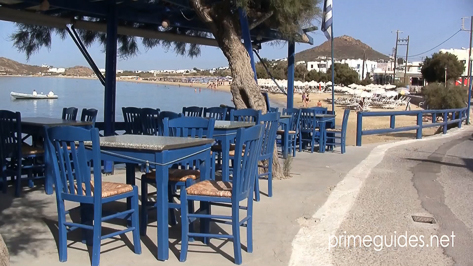
For more Hotel and Destination videos, please go to our main site at http://www.primeguides.net
Copyright- Paul Walters/Peach Imaging 2018. No part of this transcript may be reproduced without permission
